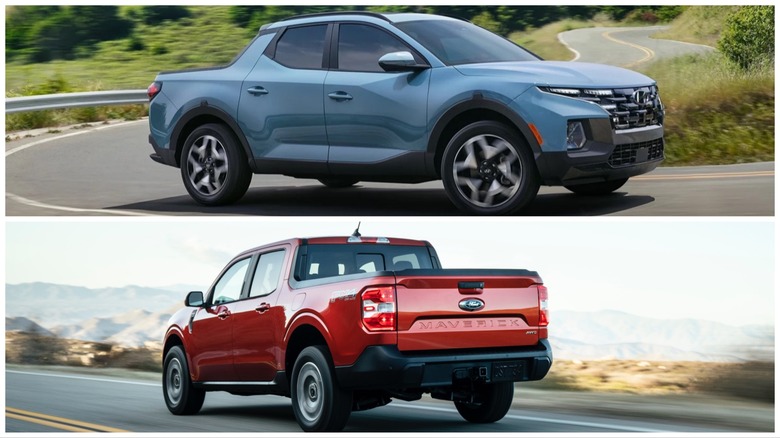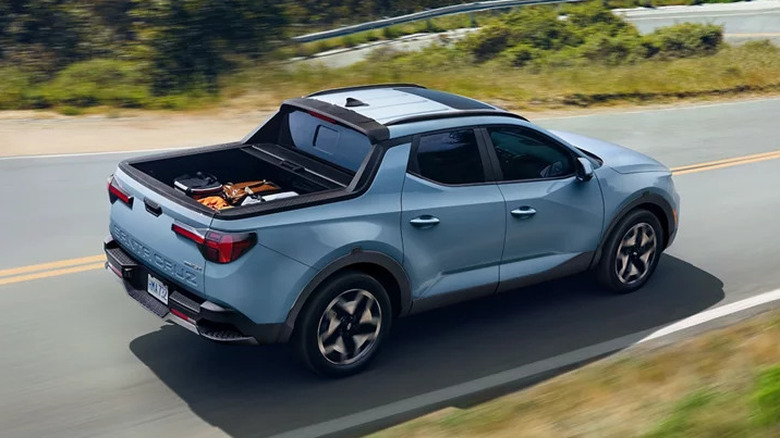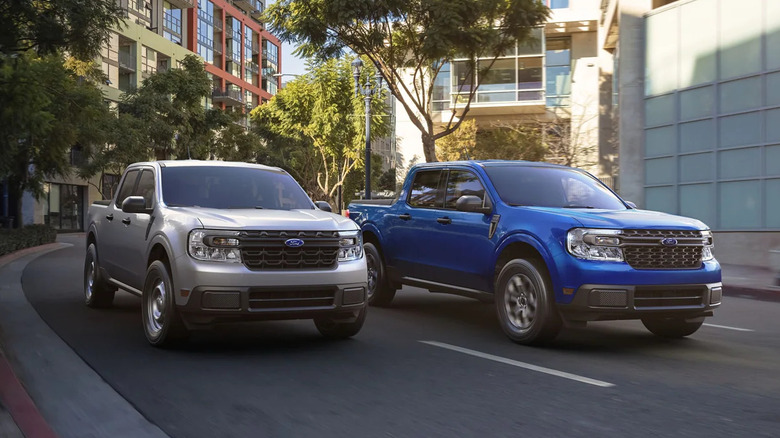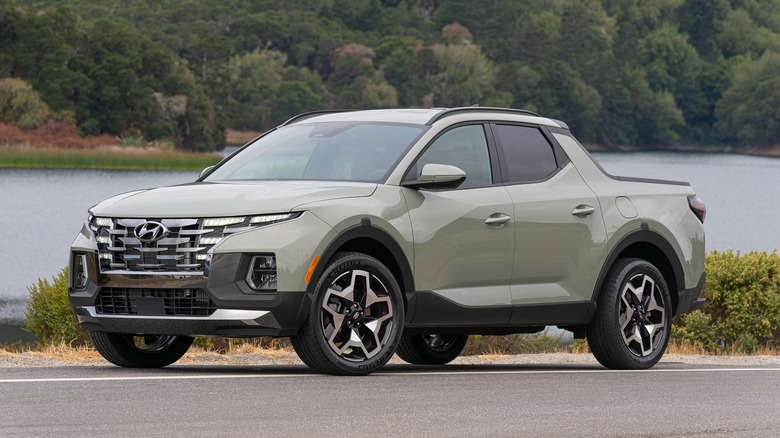2023 Ford Maverick Vs 2023 Hyundai Santa Cruz: The Best Budget Truck For You
Unless you've been living under a rock for the past few years, you're probably aware of the insatiable demand for Ford's Maverick, a compact pickup truck. The company's ordering process for 2023 models shut down after less than one week because the entire years' supply was sold out, prompting the Hermosillo, Mexico, factory where Mavericks are made to add a third shift, churning out the mini-trucks literally around the clock.
This phenomenon is proof of concept that not every pickup buyer wants or needs a huge $70,000 gas-guzzling behemoth to take the tribe camping, make a run to hardware store, or help a friend move. Even todays compact trucks like the perennial favorite Toyota Tacoma have grown significantly over the decades. Fortunately for mini-truck buyers, two good choices exist. Oft overlooked in the wake of the Maverick's popularity, Hyundai also markets a versatile mini truck called the Santa Cruz, but is it a worthy adversary for the Ford?
The Santa Cruz is more powerful, for a price
Both of these trucks are based on crossover SUVs, with unibody construction and standard front-wheel drive, but the Santa Cruz is more visually identifiable as car-based with swept back C-pillars, similar to what other countries call a "Ute," while the Maverick has more traditional boxy truck styling. For buyers living in snowy climates or yearning to venture off-road, both trucks are available with optional all-wheel drive, with the exception of the Maverick Hybrid, which brings us to discussing powertrains.
Maverick buyers are limited to one purely gasoline engine, a 2.0 liter four-cylinder producing 250 horsepower and 277 pound-feet of torque. A 2.5 liter hybrid powertain is also available, which boosts fuel economy to as high as 42 mpg for city driving. For the 2024 model year, Ford is charging an extra $1,500 for the hybrid option across most trim levels, whereas it was previously free of charge.
By comparison, Hyundai offers two distinct gasoline engines — neither hybrid — in the Santa Cruz. The base engine is a 2.5-liter four-cylinder that makes a lackluster 191 horsepower and 181 pound-feet of torque. Higher trim levels come with a much preferred turbocharged version of the same engine that delivers 281 horsepower and 311 lb-feet of torque, but at a considerable expense. The XRT and the Limited are both over $40,000.
Cargo space in both trucks is limited
In spite of their diminutive stature, the Japanese and captive import mini trucks of the 1970s and 1980s had generous cargo beds, but at the expense of only seating two or three passengers. Both the Maverick and Santa Cruz sacrifice some cargo bed space to accommodate a mandatory four-door crew-cab configuration to fit extra passengers. As a result, the Maverick's carbo bed is 54 inches long, while the Santa Cruz's is a mere 48 inches, giving a slight cargo-hauling edge to the Ford.
As far as the weight of what you can haul in those short beds, a standard Maverick has a maximum payload of 1,500 pounds and is capable of towing 2,000 pounds. With an optional towing package, the non-hybrid Maverick can tow up to 4,000 pounds. The Santa Cruz has a similar payload capacity of 1,411 pounds, but it handily beats the Ford in towing ability, with a standard 3,500 pound tow rating with the base engine and 5,000 pounds for vehicles equipped with the turbocharged motor.
Inside the cabins of the two trucks, the Hyundai receives higher marks for the quality of materials and a superior infotainment system. Although the Maverick's interior has been praised for its smart design, the materials are indicative of the truck's low price, with the widespread presence of hard plastics and exposed fasteners. By comparison, the Santa Cruz's interior is lifted directly from Hyundai's Tucson SUV and is much more refined, with premium materials and the availability of a 10.25-inch touchscreen. Both of the mini-trucks come standard with 8-inch screens and the expected integration for Apple CarPlay and Android Auto.
The Santa Cruz is easier to obtain
No discussion of these two trucks would be complete without addressing price and at least in theory, the Maverick wins with a much lower price range of $24,995 for the very basic XL trim to $39,945 for the top level Lariat Tremor Off-Road. Most buyers will likely opt for the combination of price and features offered by the midrange XLT at $27,910.
The Santa Cruz ranges from $27,985 for the entry-level SE to $42,405 for the luxe Limited model. Note that in order to nab the desirable turbocharged engine, a trim level of "Night" or higher must be selected, bringing the price of entry up to $39,545 for buyers that want a peppier driving experience.
After purchase, Hyundai is also willing to stand by its product longer than Ford, with a five year or 60,000 mile bumper-to-bumper warranty and 10 year powertrain warranty, whereas Ford provides three years or 36,000 miles comprehensive and five years of powertrain coverage, respectively. Hyundai also offers complementary maintenance for the first three years or 36,000 miles of ownership.
In a nutshell, the Hyundai has a nicer interior, longer warranty, and is overall more like a crossover SUV with a truck bed grafted onto the back. On the downside, it's more expensive than its rival, particularly if you can't tolerate the anemic base engine. That said, the Maverick has long wait times for acquisition and unscrupulous dealers and private-party resellers are attaching premiums to the popular truck for those that want one sooner and are willing to pay for the privilege, whereas the Santa Cruz is available immediately without fanfare.



